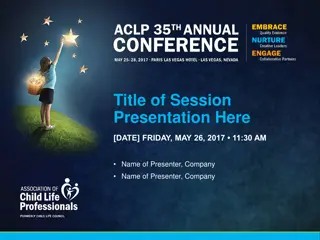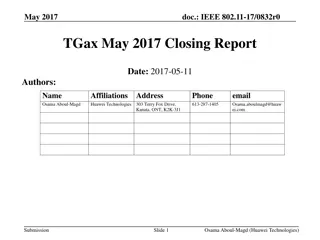
Evolution of F&A Cost Rates in Research Institutions
Discover the historical timeline of Facilities and Administrative (F&A) cost rates in research settings, from initial reimbursements to modern-day regulations like 2CFR200. Understand the concept of F&A costs, their evolution, and key regulatory changes impacting universities.
Download Presentation

Please find below an Image/Link to download the presentation.
The content on the website is provided AS IS for your information and personal use only. It may not be sold, licensed, or shared on other websites without obtaining consent from the author. If you encounter any issues during the download, it is possible that the publisher has removed the file from their server.
You are allowed to download the files provided on this website for personal or commercial use, subject to the condition that they are used lawfully. All files are the property of their respective owners.
The content on the website is provided AS IS for your information and personal use only. It may not be sold, licensed, or shared on other websites without obtaining consent from the author.
E N D
Presentation Transcript
1 F&A Facilities and Administrative Costs May 19, 2017 Office for Sponsored Programs Cost Analysis Team
2 The History And Evolution of F&A Cost Rates 1947 ONR reimbursed universities for institutional (indirect) costs incurred for Navy contracts. 1955 DHEW used this approach to set their rate at 8% of Total Direct Costs (still maximum for Training Grants) 1958 General rate of 15% for NIH fixed by law; increased to 20% in 63 Bureau of the Budget (now OMB) issues Circular A-21 1966 Government makes a commitment to fully reimburse universities for the cost of federally sponsored research 1979 A-21 major revision introduced the concept of MTDC (instead of salaries and wages) 1986 A-21 revision capped faculty administration costs @ 3.6% (allowance) establishing a precedent for capping a portion of F&A 1991 A-21 revision caps administrative components (GA,DA,SPA) @ 26%
3 The History And Evolution of F&A Cost Rates (CONTINUED) 1993 A-21 revision retains the 26% cap, adds the student services component to the cap, & establishes requirement for university research & clerical and administrative charging 1996 A-21 revision introduced Cost Accounting Standards (CAS), raises the equipment threshold from $500 to $5,000, changes the term indirect costs to facilities and administrative costs 1998 Revision June 1, 1998 Various revisions include establishing a review process to ensure reasonableness of facility costs 2000 Revision introduces a standard format for the submission of F&A proposals, including a listing of required data elements 2004 Revision makes A-21 consistent with some provisions of other OMB circulars. SSFs rates to be reviewed and adjusted at least biennially 2014 Major revisions/consolidation of eight OMB Circulars - 2CFR200 published, referred to as the Uniform Guidance (UG)
4 What is F&A? DEFINITION 2 CFR 200.56 costs incurred for common or joint purpose and not readily assignable Indirect costs must be distributed base[d on] relative benefits derived.
5 What is F&A? 2 CFR 200 Appendix III Direct Costs are incurred in support of Harvard s major functions, as defined in section A.1.: a. Instruction (A01) b. Organized research (A02) c. Other sponsored activities (A03) d. Other institutional activities (A04) All other costs are Indirect Costs. Indirect costs can benefit multiple functions or a single function.
6 8 Components of F&A Rate 2 CFR 200 Appendix III Section B. 2. Depreciation (building and equipment) 3. Interest (for debt on buildings and equipment) 4. Operations and Maintenance 5. General Administration and General Expenses * 6. Departmental Administration Expenses * 7. Sponsored Programs Administration * 8. Library Expenses 9. Student Administration and Services * * Defined as Administrative A in Section C.8. (26% cap). All others are Facilities F.
7 Administrative Costs why the Cap? Departmental Administration Includes departmental costs (including grants managers), school admin costs (deans, local H/R, finance, facility management) General Administration & General Expense President & provost offices, most of CADM Sponsored Projects Administration (SPA) OSP, part of OTD, OVPR Student Services Registrar, Bursar, Student Medical
8 Calculation of F&A Rate Indirect Costs BenefittingResearch Direct Costs of Research (MTDC) = F&A Rate Research grant expenses Over expenditures Committed Cost Sharing University-funded competitive awards 8
9 Indirect Cost Group Base Indicator Base Allocated Amount Rate Capped Rate Administrative General Administration Departmental Administration Sponsored Project Administration All All 120,986,271 $ 120,986,271 $ 119,852,212 $ $ $ $ 7,500,657 25,851,326 6,403,466 6.2% 21.4% 5.3% Sponsored $ 39,755,449 32.9% 26.0% Facilities Depreciation Interest Operations & Maintenance Library On Campus On Campus On Campus On Campus 116,525,386 $ 116,525,386 $ 116,525,386 $ 116,525,386 $ $ $ $ $ 23,944,482 5,819,251 30,784,057 5,748,468 20.5% 5.0% 26.4% 4.9% $ 66,296,258 56.9% 56.9% Calculated On Campus Rate: 89.8% 82.9% 9
10 Calculation of F&A Rate Audited Financials 10
11 Harvard s F&A Rate Structure Research On-campus Research Off-campus Other Sponsored Activities Rates through June 30, 2019: Harvard School of Public Health FY17 58.5% FY18 59.0% FY19 59.5% 69.0% 26.0% 45.0% University Area 26.0% 34.0% Wyss Institute - LMA 88.5% - - Harvard Medical School 69.5% 26.0% 38.0%
12 Base Year Concerns (FY 2018) Planning for 2018 now. FAS RAS and OSP are working together on a Dry Run using 2016 expenses and 2014 space data. The characterization of Activities as Instruction (IDR A01) v. Organized Research (OR A02) v. Other Sponsored Activity (OSA A03), particularly on less-than-full IDC awards 2 CFR 200.87 Research systematic study for a fuller knowledge or understanding 2 CFR 200 Appendix III Section A.1.b. Organized separately budgeted and accounted for
13 Base Year Concerns (FY 2018) (continued) The characterization of on campus v. off campus From Rate Agreement The University uses the rate applicable to the location where the preponderance of the time and effort will be expended. Accordingly, each contract or grant is assigned only one indirect cost rate. The off-campus rates apply to effort conducted on premises not owned by the University at a location sufficiently far removed from campus to prohibit the normal use of University facilities and services
14 Base Year Concerns (FY 2018) (continued) Use of the ineligible for federal reimbursement object codes (845x range) for non-sponsored expenses Vigilance about location and in use status of equipment Inclusion of root values on facilities-related expenses Participation and cooperation during the Space Survey
15 OSP Cost Analysis Team Jonathan Dutt jonathan_dutt@harvard.edu (617) 496-2702 Peggy Mui peggy_mui@harvard.edu (617) 496-4771 Mark (William) O Brien mark_w_obrien@harvard.edu (617) 496-2506 Judith (Ann) Ryan judith_ryan@harvard.edu (617) 496-9047






